| Monument Valley | |
|---|---|
| Tsé Biiʼ Ndzisgaii | |
 View of West Mitten Butte, East Mitten Butte, and Merrick Butte in northeastern Arizona View of West Mitten Butte, East Mitten Butte, and Merrick Butte in northeastern Arizona | |
| Highest point | |
| Elevation | 5,000 to 6,000 ft (1,500 to 1,800 m) |
| Coordinates | 36°59′N 110°6′W / 36.983°N 110.100°W / 36.983; -110.100 |
| Naming | |
| Native name | Tsé Biiʼ Ndzisgaii (Navajo) |
| Geography | |
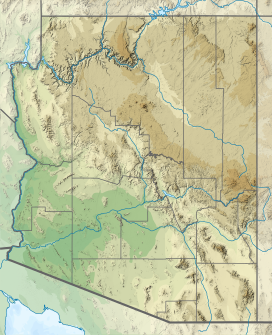  | |
| Geology | |
| Mountain type | Butte |
| Rock type | Siltstone |
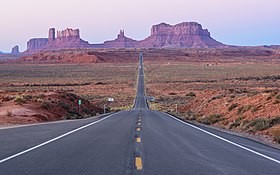

Monument Valley (Navajo: Tsé Biiʼ Ndzisgaii, pronounced [tsʰépìːʔ ǹtsɪ̀skɑ̀ìː], meaning "valley of the rocks") is a region of the Colorado Plateau characterized by a cluster of sandstone buttes, with the largest reaching 1,000 ft (300 m) above the valley floor. The most famous butte formations are located in northeastern Arizona along the Utah–Arizona state line. The valley is considered sacred by the Navajo Nation, the Native American people within whose reservation it lies.
Monument Valley has been featured in many forms of media since the 1930s. Famed director John Ford used the location for a number of his Westerns. Film critic Keith Phipps wrote that "its five square miles have defined what decades of moviegoers think of when they imagine the American West".
Geography and geology
Monument Valley is part of the Colorado Plateau. The elevation of the valley floor ranges from 5,000 to 6,000 feet (1,500 to 1,800 m) above sea level. The floor is largely siltstone of the Cutler Group, or sand derived from it, deposited by the meandering rivers that carved the valley. The valley's vivid red coloration comes from iron oxide exposed in the weathered siltstone. The darker, blue-gray rocks in the valley get their color from manganese oxide.
The buttes arising from the valley floor are clearly stratified, with three principal layers. The lowest layer is the Organ Rock Shale, the middle is de Chelly Sandstone, and the top layer is the Moenkopi Formation capped by Shinarump Conglomerate. Major rock formations include West and East Mitten Buttes, Merrick Butte, Hunts Mesa, Eagle Mesa, Sentinel Mesa, Brighams Tomb, Castle Rock, Stagecoach, Big Indian, Rain God Mesa, Spearhead Mesa, Mitchell Mesa, Mitchell Butte, Gray Whiskers, Elephant Butte, Camel Butte, Cly Butte, King-on-his-Throne, Rooster Rock, and Setting Hen. Another notable formation is Totem Pole, a highly eroded butte remanent. The valley also includes large stone structures, such as the "Eye of the Sun".
Between 1945 and 1967, the southern extent of the Monument Upwarp was mined for uranium, which occurs in scattered areas of the Shinarump Conglomerate; vanadium and copper are associated with uranium in some deposits.
Tourism

Monument Valley includes much of the area surrounding Monument Valley Navajo Tribal Park, a Navajo Nation equivalent to a national park. Oljato, for example, is also within the area designated as Monument Valley.
Visitors may pay an access fee and drive through the park on a 17-mile (27 km) dirt road. Parts of Monument Valley, such as Mystery Valley and Hunts Mesa, are accessible only by guided tour.
Climate
Monument Valley experiences a desert climate with cold winters and hot summers. While the summers may be hot, the heat is tempered by the region's high altitude. Although the valley experiences an average of 54 days above 90 °F (32 °C) annually, summer highs rarely exceed 100 °F (38 °C). Summer nights are comfortably cool, and temperatures drop quickly after sunset. Winters are cold, but daytime highs are usually above freezing. Even in the winter, temperatures below 0 °F (−18 °C) are uncommon, though possible. Monument Valley receives an occasional light snowfall in the winter; however, it usually melts within a day or two.
| Climate data for Monument Valley, Arizona | |||||||||||||
|---|---|---|---|---|---|---|---|---|---|---|---|---|---|
| Month | Jan | Feb | Mar | Apr | May | Jun | Jul | Aug | Sep | Oct | Nov | Dec | Year |
| Record high °F (°C) | 60 (16) |
69 (21) |
77 (25) |
90 (32) |
99 (37) |
101 (38) |
107 (42) |
100 (38) |
97 (36) |
86 (30) |
73 (23) |
62 (17) |
107 (42) |
| Mean maximum °F (°C) | 52.07 (11.15) |
59.41 (15.23) |
70.37 (21.32) |
80.04 (26.69) |
88.27 (31.26) |
96.64 (35.91) |
99.44 (37.47) |
96.13 (35.63) |
90.48 (32.49) |
80.36 (26.87) |
65.18 (18.43) |
51.89 (11.05) |
100.17 (37.87) |
| Mean daily maximum °F (°C) | 40.6 (4.8) |
47.3 (8.5) |
58.2 (14.6) |
67.3 (19.6) |
77.6 (25.3) |
88.1 (31.2) |
92.0 (33.3) |
88.8 (31.6) |
80.6 (27.0) |
67.9 (19.9) |
51.5 (10.8) |
40.9 (4.9) |
66.7 (19.3) |
| Mean daily minimum °F (°C) | 24.3 (−4.3) |
28.2 (−2.1) |
35.5 (1.9) |
42.4 (5.8) |
52.3 (11.3) |
63.1 (17.3) |
67.0 (19.4) |
63.9 (17.7) |
57.3 (14.1) |
45.1 (7.3) |
32.9 (0.5) |
24.6 (−4.1) |
44.7 (7.1) |
| Mean minimum °F (°C) | 12.25 (−10.97) |
15.25 (−9.31) |
22.04 (−5.53) |
28.69 (−1.84) |
35.24 (1.80) |
47.08 (8.38) |
57.58 (14.21) |
54.73 (12.63) |
44.72 (7.07) |
32.61 (0.34) |
18.75 (−7.36) |
12.78 (−10.68) |
11.50 (−11.39) |
| Record low °F (°C) | −8 (−22) |
−4 (−20) |
9 (−13) |
15 (−9) |
20 (−7) |
31 (−1) |
49 (9) |
38 (3) |
33 (1) |
22 (−6) |
6 (−14) |
−9 (−23) |
−9 (−23) |
| Average precipitation inches (mm) | 0.26 (6.6) |
0.19 (4.8) |
0.19 (4.8) |
0.24 (6.1) |
0.30 (7.6) |
0.10 (2.5) |
0.54 (14) |
0.79 (20) |
0.73 (19) |
0.68 (17) |
0.32 (8.1) |
0.19 (4.8) |
4.54 (115) |
| Source: The Western Regional Climate Center | |||||||||||||
In visual media

Monument Valley has been featured in numerous computer games, in print, and in motion pictures, including multiple Westerns directed by John Ford that influenced audiences' view of the American West, such as: Stagecoach (1939), My Darling Clementine (1946), Fort Apache (1948), She Wore a Yellow Ribbon (1949), and The Searchers (1956).
Many more recent movies, with other directors, were also filmed in Monument Valley, including Sergio Leone's Once Upon a Time in the West (in 1967), the first Spaghetti Western to be filmed outside Europe, and Gore Verbinski's The Lone Ranger.
Gallery
-
 Monument Valley, the Thumb
Monument Valley, the Thumb
-
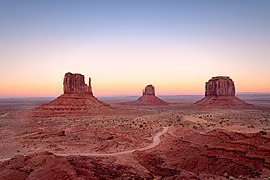 West, East Mittens and Merrick Butte after sunset
West, East Mittens and Merrick Butte after sunset
-
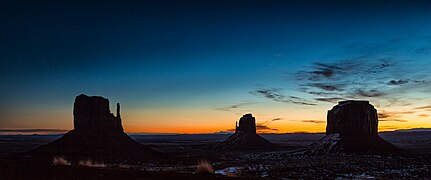 Snow-covered Monument Valley sunrise in January
Snow-covered Monument Valley sunrise in January
-
 Monument Valley West and East Butte at 6:00 am
Monument Valley West and East Butte at 6:00 am
-
 Sandstorm in Monument Valley
Sandstorm in Monument Valley
-
 Vegetation of Monument Valley
Vegetation of Monument Valley
-
 Monument Valley landscape
Monument Valley landscape
-
 View on the Monument Valley from Hunts mesa
View on the Monument Valley from Hunts mesa
-
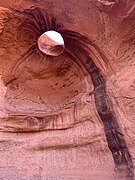 Monument Valley rock formation
Monument Valley rock formation
-
 Mystery Valley
Mystery Valley
Panorama


See also
References
- Scheffel, Richard L.; Wernet, Susan J., eds. (1980). Natural Wonders of the World. Reader's Digest. p. 255. ISBN 978-0895770875.
- King, Farina (2018). "Náhookọs (North): New Hioes for Diné Students." The Earth Memory Compass: Diné Landscapes and Education in the Twentieth Century. University Press of Kansas. pp. 142–74. doi:10.2307/j.ctv6mtdsj. S2CID 135010884.
- ^ Phipps, Keith (November 17, 2009). "The Easy Rider Road Trip". Slate. Retrieved December 16, 2012.
- Malan, Roger C. (1968). "The uranium mining industry and geology of the Monument Valley and White canyon districts, Arizona and Utah". Ore Deposits of the United States, 1933–1967. New York: American Institute of Mining Engineers. pp. 790–804.
- "Seasonal Temperature and Precipitation Information". Western Regional Climate Center. Retrieved March 24, 2013.
- Howze, William (September 2, 2011). "Ford's consistent use of popular imagery in Western and Non-Western films". The Influence of Western Painting and Genre Painting on the Films of John Ford (Revised ed.). "Ford is popularly regarded as a director of westerns, the director who made John Wayne a star and made Monument Valley the locus for the myth of the American West. It was a reputation he encouraged. 'My name's John Ford – I make westerns', he once said by way of introduction.1 Among his most popular westerns are Staqecoach (1939), My Darlinq Clementine (1946), Fort Apache (1947), She Wore a Yellow Ribbon (1949), The Searchers (1956), and The Man Who Shot Liberty Valance (1962). "Western or non-western, Ford's films exhibit characteristics that transcend those categories. Critics have recognized Ford's preoccupation with the traditional values of home and country, whether the country is Ireland or the United States; they have characterized his heroes as loners, men disappointed with life in some way that is only implied; and they have enumerated the elements of a typical Ford film: Monument Valley, the Seventh Cavalry, a fight, a dance, a wedding, a funeral, and the members of the so-called John Ford Stock Company, actors who appeared again and again in his films: John Wayne, Victor McLaglen, Henry Fonda, Ward Bond, Olive Carey, Harry Carey, Jr., John Qualen, and Hank Worden among others.
- Punch, David A. (September 2, 2018). "Stagecoach: Defining the Western, How John Ford's 1939 western classic transformed the dying genre into the epitome of American cinema". Medium. "Monument Valley resides on the Utah–Arizona border, within the territory of the Navajo Reservation. Encompassing approximately 30,000 acres, the land is noteworthy for its incredible sandstone buttes, which reach as high as 1,000 ft. Realizing how magnificent the location would be for a western picture, resident Harry Goulding approached John Ford about shooting his next film there. After previewing the landscape through some pictures Goulding brought along with him, Ford was certain he wanted to film Stagecoach there. Some of the motivation for that was the remoteness of the location. Hundreds of miles away from any form of civilization, it certainly discouraged nosey producers from prying, though the natural beauty of the terrain was a deciding factor. It became his preferred location for shooting westerns; Ford favored its majesty over accuracy in films like My Darling Clementine (1946), set in Tombstone, Arizona, and The Searchers, which substitutes the location for practically everywhere the characters travel to. The expansive countryside embodied the untamed potential of the western frontier so vividly it has become the iconic image of the west. Ford's discovery of Monument Valley was crucial in piecing together his image of the frontier — a vision which has become the defining portrait of the American West."
- Movshovitz, Howard (1984). "The Still Point: Women in the Westerns of John Ford". Frontiers: A Journal of Women Studies. 7 (3, Women on the Western Frontier). University of Nebraska Press: 68–72. doi:10.2307/3346245. JSTOR 3346245.
- "50 Years Ago, Two Iconic Films Featured Monument Valley". 2017-06-05.
Further reading
- Harvey, Thomas J. (2011). Rainbow Bridge to Monument Valley: Making the Modern Old West. University of Oklahoma Press. ISBN 978-0806141909.
External links
- "Monument Valley Tours & Tickets". Travel Guide.
- "Complete Monument Valley Guide: Drive, Hotels, Camping, Seasons". When To Go. 2017-11-12.
- "List of movies and television shows with scenes in Monument Valley". IMDb.
- "Monument Valley". American Southwest Guide.
- "Monument Valley". Navajo Nation Parks. Archived from the original on 2006-01-04.
- "Photographs and documents of pre-automobile access Monument Valley from the Monument Highway Digital Collection". Utah State University.
- "Uranium mining in Monument Valley and its decommissioning". Energy Information Administration. Archived from the original on 2003-10-14.
- Native American culture
- Buttes of Arizona
- Landforms of Apache County, Arizona
- Landforms of Navajo County, Arizona
- Colorado Plateau
- Regions of Arizona
- Valleys of Arizona
- Rock formations of Arizona
- Valleys of Utah
- Rock formations of Utah
- Regions of Utah
- Landforms of San Juan County, Utah
- Religious places of the Indigenous peoples of North America
- Protected areas of Apache County, Arizona
- Protected areas of Navajo County, Arizona
- Protected areas of San Juan County, Utah
- Sacred mountains of the Americas
- Sacred rocks
- Tourist attractions in Utah
- Geography of the Navajo Nation